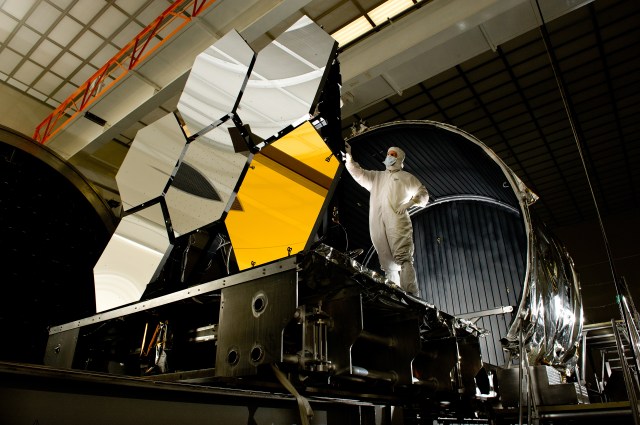


Space Environments
Large-scale and other uniquely purposed chambers replicate extreme environments to certify performance of spacecraft, structures, components and instrumentation
8-Foot-by-15-Foot Thermal Vacuum Chamber
- Housed at NASA’s Langley Research Center, the 8-Foot-by-15-Foot Thermal Vacuum Chamber has undergone several significant modifications to increase testing capability, safety, and the quality of articles-testing measurements.
15-Foot Chamber
- NASA’s Johnson Space Center’s 15-Foot Chamber encloses a spherical space designed to test advanced concepts for battery-power systems, space vehicle actuators, and auxiliary power units.
20-Foot Chamber
- The 20-Foot Chamber at NASA’s Johnson Space Center’s is currently being reconfigured to support future deep-space environmental control and life support systems (ECLSS) research as part of NASA’s Human Exploration System Testbed for Integration and Advancement (HESTIA) Project.
20-Foot Chamber / Building 353
- The 20-Foot Chamber in Building 353 at NASA’s Johnson Space Center houses the capability to test a full range of fluid and chemical processes associated with the collection, processing, storage and use of planetary-surface resources.
25-Foot Space Simulator
- The 25-Foot Space Simulator at NASA’s Jet Propulsion Laboratory is designed for environmental testing of robotic spacecraft in simulated interplanetary conditions of extreme cold, high vacuum and intense solar radiation. Most recently, the 25-Foot hosted studies of Mars 2020 mission vehicles: both the Perseverance rover and the Mars helicopter Ingenuity.
Small Multi-Purpose Research Facility
- The Small Multi-Purpose Research Facility (SMiRF) at NASA’s Glenn Research Center evaluates the performance of thermal protection systems required to provide long-term storage and transfer of cryogenic propellants in space.
Space Environments Complex
- Located at the Armstrong Test Facility, part of NASA’s Glenn Research Center, the Space Environments Complex (SEC) is home to four space-dedicated testing laboratories. The complex assesses stresses during liftoff, flight and extended missions from vibration and sound, electromagnetic radiation, and the general impacts of continued exposure to a hard vacuum.
Space Environment Simulator
- Located at NASA’s Goddard Space Flight Center, the Space Environment Simulator is a large, vertical cryopumped test chamber capable of achieving ultra-low pressures and a wide range of thermal conditions.
Spacecraft Magnetic Test Facility
- The Spacecraft Magnetic Test Facility is housed at NASA’s Goddard Space Flight Center. It was built in 1966 to allow the evaluation of magnetic movement in crewed and uncrewed spacecraft, and for the precision calibration of magnetometers used in spaceflight. Before their successful launches and deployments, a number of communications, weather and Earth resources satellites were tested in the facility.
Sunspot Thermal Vacuum Testing Facility
- The Sunspot Thermal Vacuum Testing Facility is located at NASA’s Marshall Space Flight Center (MSFC), part of the MSFC Environmental Test Facilities complex used to simulate the harsh environments encountered by space-borne craft and components. Large test articles may be lowered into Sunspot through the top of the chamber via an overhead crane.
Test Stand 20-Foot Chamber
- The East Test Area at NASA’s Marshall Space Flight Center has five major test stands. These research and development facilities are capable of testing high pressure pumps, both fuel and oxidizer, injectors, chambers, and sea-level engine assemblies, as well as simulating deep space environments in the 12- 15- and 20-Foot vacuum chambers.
Thermal Vacuum Chamber A
- NASA Johnson Space Center’s Thermal Vacuum Chamber A is a large-scale facility famous for testing Apollo spacecraft, and hosted the James Webb Space Telescope for final cryogenic testing to simulate the frigid conditions the instrument will encounter. The chamber’s physical volume and high-fidelity space simulation capabilities are adjustable for thermal-vacuum studies of a wide variety of craft and components, including entire space vehicles.
Thermal Vacuum Chamber B
- NASA Johnson Space Center’s Thermal Vacuum Chamber B is used for crewed space operations testing in vacuum, where space-suited astronauts practice a variety of tasks in a simulated low-gravity environment. The chamber features dual crew locks to provide easy access to test articles and a means of transporting crewmembers to and from the chamber.
Thermal Vacuum Chamber V-20
- Thermal Vacuum Chamber V-20 is located at NASA’s Marshall Space Flight Center (MSFC), part of the MSFC Environmental Test Facilities complex used to simulate the harsh environments encountered by space-borne craft and components. Most recently, this chamber was used to perform a leak test on the Orion crew module, which is slated to carry astronauts back to the Moon as part of the Artemis mission.
Thermal Vacuum Facilities 5 and 6
- NASA Glenn Research Center’s Electric Propulsion and Power Laboratory, formerly known as the Electric Propulsion Laboratory, supports research and development of spacecraft power and electric propulsion systems in Thermal Vacuum Facilities 5 and 6. The chambers have been enhanced to support the unique requirements of electric propulsion and power-system testing.
Vacuum Facility 3
- With a focus as a pulsed plasma-thruster testbed, the Vacuum Facility 3 (VF-3) is part of NASA’s Glenn Research Center’s Electric Propulsion Research Building (EPRB) complex, whose capabilities center on a suite of vacuum chambers configured to meet the unique requirements related to electric propulsion, spacecraft power, and space environmental effects.
X-Ray and Cryogenic Facility
- NASA’s X-Ray and Cryogenic Facility (XRCF) is an adaptable space environment simulation facility that has been enabling technology development and pre-flight verification of space missions since 1991. As the Agency’s premier cryogenic optical test facility, the XRCF enables the development and pre-flight evaluation of large direct-incidence telescope mirrors and structures in relevant thermal environments.








































